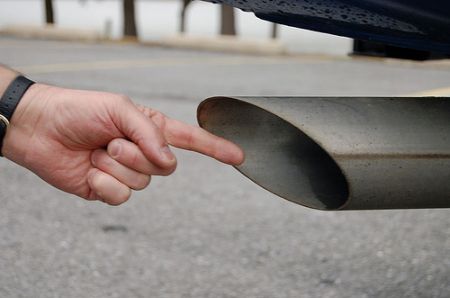Car Corner: Obama's Proposed Fuel And Emissions Policies
Comments (2)

The Obama Administration's new efficiency standards could make less
work for tailpipes. (Photo by Flickr member Rob Lightbody)
The Obama administration has released a set of proposed fuel economy and emissions standards that will dramatically affect the vehicles in showrooms across the U.S. Many find fuel economy to be one of the more important buying considerations, but it isn't clear how many people actually understand this new plan's potential impacts. Neon Tommy breaks down the important details impacting you and the automakers.
The new standards would force automakers to reach 35.5 mpg for their lineups by 2016, four years before the original plan considered in 2007. Is four years really such a big deal?
Yes, four years is a big deal. It takes at least three years to engineer most new vehicles from the time executives approve a development project to the moment the first unit arrives in showrooms. Automakers plan their fleets years in advance, so moving the timetables forward does have an impact--and you can bet that incorporating fuel-efficient technology into new vehicles isn't always cheap.
How much money will fuel-efficient technology cost to put into new vehicles?
The government estimates that a new car with technology to help meet the new standards will retail for $1300 more than the current vehicle. Someone buying a luxury vehicle is more likely to be able to afford that premium than another consumer considering $15,000 sedans. One administration official has said that new car buyers will save $160 a year, on average, by buying vehicles that meet the new fuel efficiency standards. That's important to remember, but what happens if not enough people are willing to pay the initial cost?
Why don't the automakers import fuel-efficient vehicles already sold in other countries?
In some cases, they already do, but Americans don't buy the smaller vehicles in numbers anywhere near those of midsize cars. Consider the Honda Fit and Toyota Yaris, two subcompact vehicles sold in other countries with minimal changes to the ones we see in American dealerships. Through the first 10 months of the year, both automakers sold more than four times as many midsize sedans as subcompact vehicles.
American consumers usually opt for larger and more powerful vehicles than those sold in Europe. Ford's F-150 truck will probably finish 2009 once again the most popular vehicle in America--you won't see that happen in Europe. There is hope for this problem of low demand, though. Ford will be selling an extremely popular vehicle abroad called the Fiesta here next year and Chevrolet will introduce a compact sedan called the Cruze that is said to get nearly 40 mpg. The question now is whether people will buy these cars.
Why do automakers - both foreign and domestic - sometimes emphasize larger vehicles?
It is much more difficult to make money on small cars than on large trucks and SUVs. Take Toyota as an example. Yes, Toyota was one of the first automakers to invest in hybrid technology before it became popular, but Toyota is also the automaker that spent more than $1 billion developing a truck plant in Texas. There's nothing wrong with that--trucks and SUVs simply have higher profit margins.
How will the price of gas affect the fuel economy plan?
If gas prices don't rise quickly enough to encourage people to buy smaller fuel-efficient vehicles, government incentives or even a higher gas tax might be necessary to spur demand. After gas prices stabilized (following $4.00 a gallon gas here in California), sales of efficient vehicles like hybrids fell faster than other market segments. So if people don't naturally start choosing the more efficient vehicles, a little encouragement from the government might help move things along.
Where does California fit into this picture?
For years, California had stricter emissions regulations than those required by the federal government. A handful of states followed California's lead, helping make vehicles sold in these states cleaner than those sold elsewhere. Building a car to meet two sets of emissions standards is difficult, but California has agreed to fall in line with the rest of the nation on these proposed fuel economy and emissions standards, giving automakers a clear set of guidelines of what targets they must achieve.
So fuel economy rules are getting stricter. What about automotive safety?
Vehicles today are safer than they were 20 years ago. This is largely the result of now-standard features like dual front air bags and the difficult safety tests performed by the National Highway Traffic Safety Administration and the Insurance Institute for Highway Safety. Just this year, the NHTSA announced it would be doubling the current roof strength requirement for vehicles weighing up to 6,000 pounds. Safer vehicles often means heavier vehicles and weight, of course, is the enemy of good fuel economy.



